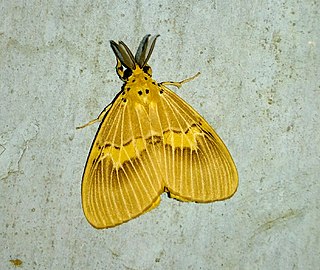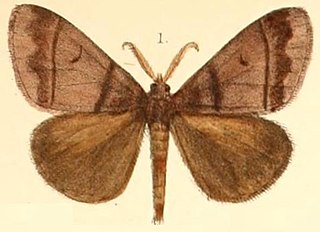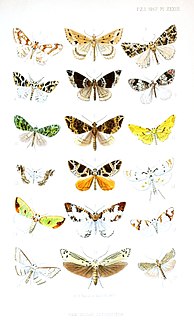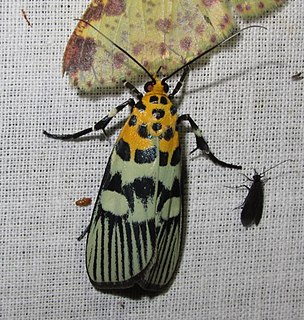Related Research Articles
Calymniops is a monotypic moth genus of the family Erebidae erected by George Hampson in 1926. Its only species, Calymniops trapezata, was first described by Moore in 1887. It is found in India, Sri Lanka, Japan and parts of North America.
Rhangena is a monotypic moth genus of the family Erebidae. Its only species, Rhangena roseipennis, is found in India and Sri Lanka. Both the genus and the species were first described by Moore in 1886.
Cispia is a genus of tussock moths in the family Erebidae. It was described by Francis Walker in 1855. They are found in India, Bhutan, Sri Lanka, China and southeast Asia.

Homona coffearia, the tea tortrix or camellia tortrix, is a moth of the family Tortricidae. The species was first described by Nietner in 1861. It is widely distributed in the Oriental region.
Teldenia alba is a moth in the family Drepanidae. It was described by Moore in 1882. It is found in Sri Lanka.

Cispia punctifascia is a moth of the family Erebidae first described by Francis Walker in 1855. It is found in India, Sri Lanka, Sumatra, Borneo and originated in Malaysia.

Euproctis cervina is a moth of the family Erebidae first described by Moore in 1877. It is found in Sri Lanka.
Euproctis fraterna is a moth of the family Erebidae first described by Moore in 1883. It is found in the Maldives, India, Sri Lanka and the Seychelles.
Euproctis rhoda is a moth of the family Erebidae first described by Moore in 1879. It is sometimes classified as a subspecies of Euproctis howra. It is found in India, Sri Lanka, Myanmar, the Andaman Islands and Australia.
Laelia fasciata is a moth of the family Erebidae first described by Moore in 1883. It is found in Sri Lanka, India and Myanmar. One subspecies is recognized, Laelia fasciata rubripennisMoore, 1884.
Lymantria fuliginosa is a moth of the family Erebidae first described by Moore in 1883. It is found in Sri Lanka and India.
Lymantria todara is a moth of the family Erebidae first described by Moore in 1879. It is found in India (Nilgiri) and Sri Lanka.

Corymica specularia is a moth of the family Geometridae first described by Moore in 1867. It is found in Sri Lanka, India and Taiwan.
Cusuma vilis is a moth of the family Geometridae first described by Francis Walker in 1854. It is found in Sri Lanka.
Dysphania prunicolor is a moth of the family Geometridae first described by Moore in 1879. It is found in India and may be found in Sri Lanka.
Spaniocentra pannosa is a moth of the family Geometridae first described by Moore in 1887. It is found in Sri Lanka.

Sauris interruptata is a moth of the family Geometridae first described by Moore in 1888. It is found in India's north-east Himalayas, Sri Lanka, the Ryukyu Islands, Taiwan, Myanmar, Peninsular Malaysia, Borneo, the Philippines, and possibly the Moluccas and New Guinea.

Vitessa suradeva is a moth of the family Pyralidae. It is found in India, Bangladesh, Myanmar, Thailand, Vietnam and Sri Lanka.

Craniophora fasciata is a moth of the family Noctuidae first described by Moore in 1884. It is found in Sri Lanka, Japan, Korea, Taiwan, Thailand and Australia.

Cheromettia apicata is a moth of the family Limacodidae first described by Moore in 1879. It is found in Oriental tropics such as Sri Lanka and India.
References
- ↑ "Species Details: Cispia alba Moore, 1879". Catalogue of Life. Retrieved 7 March 2018.
- ↑ Koçak, Ahmet Ömer; Kemal, Muhabbet (20 February 2012). "Preliminary list of the Lepidoptera of Sri Lanka". Cesa News. Centre for Entomological Studies Ankara (79): 1–57 – via Academia.
- ↑ Savela, Markku. "Cispia alba (Moore, 1879)". Lepidoptera and Some Other Life Forms. Retrieved October 5, 2018.
- ↑ "HOSTS - a Database of the World's Lepidopteran Hostplants". The Natural History Museum. Retrieved 7 March 2018.
| This article on a moth of the subfamily Lymantriinae is a stub. You can help Wikipedia by expanding it. |